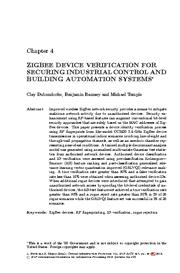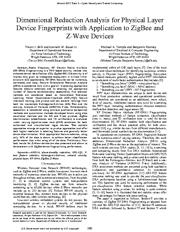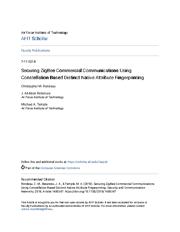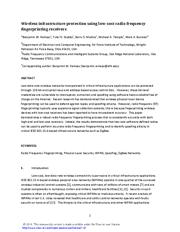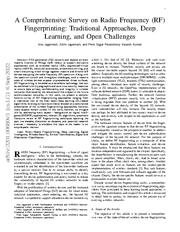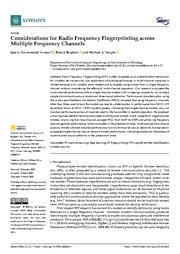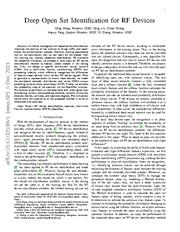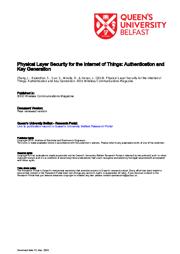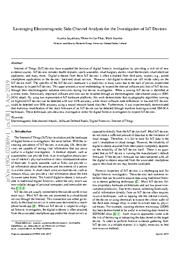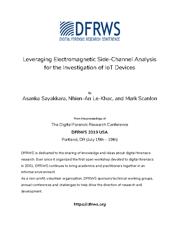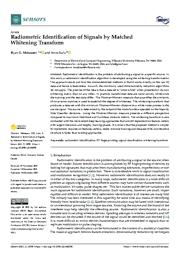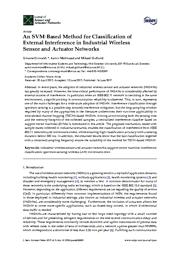A copy of this work was available on the public web and has been preserved in the Wayback Machine. The capture dates from 2018; you can also visit the original URL.
The file type is application/pdf.
Filters
ZigBee Device Verification for Securing Industrial Control and Building Automation Systems
[chapter]
2013
IFIP Advances in Information and Communication Technology
A trained multiple discriminant analysis model was generated using normalized multivariate Gaussian test statistics from authorized network devices. ...
This paper presents a device identity verification process using RF fingerprints from like-model CC2420 2.4 GHz ZigBee device transmissions in operational indoor scenarios involving line-of-sight and through-wall ...
Recent work has shown that, once they are identified and extracted, PHY-based features (e.g., RF fingerprints) can achieve human-like device discrimination even when using a relatively simple multiple ...
doi:10.1007/978-3-642-45330-4_4
fatcat:exzvmti7cbdytittrcvs5eyeja
Dimensional reduction analysis for Physical Layer device fingerprints with application to ZigBee and Z-Wave devices
2015
MILCOM 2015 - 2015 IEEE Military Communications Conference
Preliminary firstlook results for Z-Wave devices are also presented and shown to be consistent with ZigBee device fingerprinting performance. ...
Feature Dimensional Reduction Analysis (DRA) is considered here with a goal of: 1) selecting appropriate features (feature selection) and 2) selecting the appropriate number of features (dimensionality ...
Prior work [12] demonstrated γ-values offering comparable performance to KS-test p-value ranking for ZigBee feature selection with multiple discriminant analysis (MDA).
2) Kolmogorov-Smirnov Test ( ...
doi:10.1109/milcom.2015.7357469
dblp:conf/milcom/BihlBTR15
fatcat:xrbczgvy5vgpfhrq5oeakywo2y
Securing ZigBee Commercial Communications Using Constellation Based Distinct Native Attribute Fingerprinting
2018
Security and Communication Networks
Authorized network device fingerprints are used to train a Multiple Discriminant Analysis (MDA) classifier and Rogue Rejection Rate (RRR) estimated for 2520 attacks involving rogue devices presenting themselves ...
This work provides development of Constellation Based DNA (CB-DNA) Fingerprinting for use in systems employing quadrature modulations and includes network protection demonstrations for ZigBee offset quadrature ...
Device discrimination (classification and ID verification) is performed using DNA fingerprints with a Multiple Discriminant Analysis/Maximum Likelihood (MDA/ML) process adopted from [11] . ...
doi:10.1155/2018/1489347
fatcat:auxrcslysjhhzkcqcegtrbnrqq
Wireless infrastructure protection using low-cost radio frequency fingerprinting receivers
2015
International Journal of Critical Infrastructure Protection
However, radio frequency (RF) fingerprinting typically uses expensive signal collection systems; this is because fingerprinting wireless devices with low-cost receivers has been reported to have inconsistent ...
Recent research has demonstrated that wireless physical layer device fingerprinting can be used to defend against replay and spoofing attacks. ...
Acknowledgements The authors thank the reviewers for their insightful comments. ...
doi:10.1016/j.ijcip.2014.11.002
fatcat:shb5qsppqrgelfec44w7kte6ja
A Comprehensive Survey on Radio Frequency (RF) Fingerprinting: Traditional Approaches, Deep Learning, and Open Challenges
[article]
2022
arXiv
pre-print
RF fingerprinting is heralded as a candidate technology that can be combined with cryptographic and zero-trust security measures to ensure data privacy, confidentiality, and integrity in wireless networks ...
Along with the spectrum crunch and throughput challenges, such a massive scale of wireless devices exposes unprecedented threat surfaces. ...
This approach employs frequency domain analysis with a traditional discriminatory classifier -k-NN -for RF fingerprinting and device identification. ...
arXiv:2201.00680v3
fatcat:435d72iv6zgi7f2exu2tynlcpm
Considerations for Radio Frequency Fingerprinting across Multiple Frequency Channels
2022
Sensors
Our research evaluated the multi-channel performance of four single-channel models with increasing complexity, to include a simple discriminant analysis model and three neural networks. ...
Radio Frequency Fingerprinting (RFF) is often proposed as an authentication mechanism for wireless device security, but application of existing techniques in multi-channel scenarios is limited because ...
This paper is approved for public release, Case #: 88ABW-2021-1055. ...
doi:10.3390/s22062111
pmid:35336280
pmcid:PMC8955887
fatcat:mohx6mftxfdhfpwuifssmvhmx4
MAGNETO: Fingerprinting USB Flash Drives via Unintentional Magnetic Emissions
[article]
2020
arXiv
pre-print
We show that the magnetic emissions radiated during boot operations on a specific host are unique for each device, and sufficient to uniquely fingerprint both the brand and the model of the USB flash drive ...
, or the specific USB device, depending on the used equipment. ...
This publication was made possible by awards NPRP11S-0109-180242 and GSRA6-1-0528-19046, from the QNRF-Qatar National Research Fund, a member of Qatar Foundation. ...
arXiv:2002.05905v3
fatcat:7fesxg72onacrfl4mthnhhuqsy
Deep Open Set Identification for RF Devices
[article]
2021
arXiv
pre-print
various RF device signals. ...
First, we design a specific convolution neural network (CNN) with a short-time Fourier transforming (STFT) pre-processing module, which efficiently recognizes the differences of feature maps learned from ...
Temple, “Feature selection for
RF fingerprinting with multiple discriminant analysis and using zigbee
Fig. 9. ...
arXiv:2112.02536v1
fatcat:g2k4d7ntxjh3teivnomr5kfml4
Physical Layer Security for the Internet of Things: Authentication and Key Generation
2019
IEEE wireless communications
In particular, the slight random difference among transceivers is extracted for creating a unique radio frequency fingerprint and for ascertaining the unique user identity. ...
A low-complexity, yet secure framework is proposed for protecting the Internet of Things (IoT) and for achieving both authentication and secure communication. ...
The feature classification was carried out by projecting features into a subspace using the Fisher Linear discriminant analysis and then their Mahalanobis distance was measured. ...
doi:10.1109/mwc.2019.1800455
fatcat:pn73ut43vrdsbb64q4gtcmymjq
Leveraging Electromagnetic Side-Channel Analysis for the Investigation of IoT Devices
[article]
2019
arXiv
pre-print
By using two representative IoT hardware platforms, this work demonstrates that cryptographic algorithms running on high-end IoT devices can be detected with over 82% accuracy, while minor software code ...
These techniques provide a new investigative vector for digital forensic investigators to inspect IoT devices. ...
Lukacs et al. used multiple discriminant analysis (MDL) in order to reduce the dimensionality of RF-DNA fingerprints before applying them into a maximum likelihood (ML) classifier to identify known radio ...
arXiv:1904.02089v1
fatcat:bmijua54ozhyxiz6x5emk7w3bi
Leveraging Electromagnetic Side-Channel Analysis for the Investigation of IoT Devices
2019
Digital Investigation. The International Journal of Digital Forensics and Incident Response
Lukacs et al. used multiple discriminant analysis (MDL) in order to reduce the dimensionality of RF-DNA fingerprints before applying them into a maximum likelihood (ML) classifier to identify known radio ...
RF-DNA fingerprinting is a technique to fingerprint the radio signals transmitted by various devices including WiFi, Bluetooth, Zigbee, GSM devices, RADAR antennas, etc. ...
doi:10.1016/j.diin.2019.04.012
fatcat:ppyje733ojb3nbtwh3dukjycuq
Radiometric Identification of Signals by Matched Whitening Transform
2021
Sensors
The whitening transform is also contrasted with the more recent deep learning approaches that are still dependent on feature vectors with large dimensions and lengthy training phases. ...
Using the Förstner-Moonen measure presents a different perspective compared to maximum likelihood and Euclidean distance metrics. ...
In [15] , DL is implemented for RF device fingerprinting in the cognitive Zigbee networks using the time-domain complex baseband error signal as training and test data.The results show good accuracy ( ...
doi:10.3390/s21248398
pmid:34960490
pmcid:PMC8703473
fatcat:bcygcl3qmzeslmh3hcvyuyhtjq
A Review of Indoor Localization Technologies: towards Navigational Assistance for Topographical Disorientation
[chapter]
2010
Ambient Intelligence
For each selected technology, the fundamental scientific mechanisms for localization are explained, key recent literature appraised and the merits and limitations are discussed. ...
Indoor localization technologies hold promise for many ambient intelligence applications, including in-situ navigational assistance for individuals with wayfinding difficulties. ...
A Linear Discriminant Analysis (LDA) was applied to reduce the dimensionality of the features which defined each location. ...
doi:10.5772/8678
fatcat:lh2nqj6jxna6pgryf3gqqmdrxq
An SVM-Based Method for Classification of External Interference in Industrial Wireless Sensor and Actuator Networks
2017
Journal of Sensor and Actuator Networks
In addition, the obtained results show that the fast classification together with a contained sampling frequency ensure the suitability of the method for TSCH-based IWSAN. ...
The proposed mechanism, tested with sample traces collected in industrial scenarios, enables the classification of interference from IEEE 802.11 networks and microwave ovens, while ensuring high classification ...
Acknowledgments: The authors would like to thank Imerys Mineral AB for the access to their production plant in Sundsvall and R.Rondón from Mid Sweden University for the helpful feedback. ...
doi:10.3390/jsan6020009
fatcat:irxs5dvdezh2nou42xx6d36ouy
A Survey on Wireless Indoor Localization from the Device Perspective
2016
ACM Computing Surveys
trends in (1) leveraging smartphones to integrate wireless and sensor capabilities and extend to the social context for device-based localization, and (2) extracting specific wireless features to trigger ...
Besides, a review of multiple specific hardware-based technologies, including ultrawideband (UWB), ultrasonic, infrared, RFID, and Zigbee, is also presented. ...
ACKNOWLEDGMENTS The authors would like to thank the anonymous reviewers and the associate editor for their valuable comments. ...
doi:10.1145/2933232
fatcat:5zoyp6d6knelrmkj2tx6gd4utu
« Previous
Showing results 1 — 15 out of 75 results

